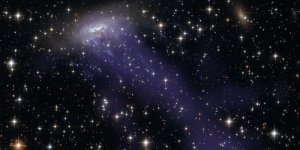| News / Science News |
Dead Star Circled by Light
New images from ESO’s Very Large Telescope in Chile and other telescopes reveal a rich landscape of stars and glowing clouds of gas in one of our closest neighbouring galaxies, the Small Magellanic Cloud. The pictures have allowed astronomers to identify an elusive stellar corpse buried among filaments of gas left behind by a 2000-year-old supernova explosion.

An isolated neutron star in the Small Magellanic Cloud. ![]()
New data has revealed a remarkable ring of gas in a system called 1E 0102.2-7219, expanding slowly within the depths of numerous other fast-moving filaments of gas and dust left behind after a supernova explosion. This discovery allowed a team led by Frédéric Vogt, an ESO Fellow in Chile, to track down the first ever isolated neutron star with low magnetic field located beyond our own Milky Way galaxy.
The team noticed that the ring was centred on an X-ray source that had been noted years before and designated p1. The nature of this source had remained a mystery. In particular, it was not clear whether p1 actually lies inside the remnant or behind it. It was only when the ring of gas — which includes both neon and oxygen — was observed with MUSE that the science team noticed it perfectly circled p1.
The coincidence was too great, and they realised that p1 must lie within the supernova remnant itself. Once p1’s location was known, the team used existing X-ray observations of this target from the Chandra X-ray Observatory to determine that it must be an isolated neutron star, with a low magnetic field.
When massive stars explode as supernovae, they leave behind a curdled web of hot gas and dust, known as a supernova remnant. These turbulent structures are key to the redistribution of the heavier elements — which are cooked up by massive stars as they live and die — into the interstellar medium, where they eventually form new stars and planets. (ESO)
YOU MAY ALSO LIKE




